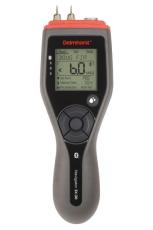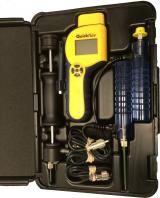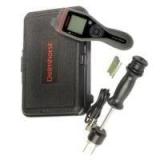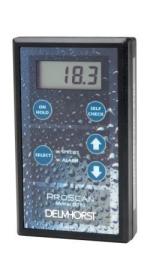Why Should I Use A Moisture Meter?
Structurally sound and beautiful in appearance, wood is the ideal raw material. Delmhorst customers in the woodworking/lumber industry know that moisture content is the single most important factor affecting the quality of their products.
To ensure quality, from the mill and dry kiln to the finishing floor, Delmhorst moisture meters help minimize defects such as shrinkage, cracks, and splits. Years of experience, high-tech tools and controls, and premium grade lumber cannot make a difference if moisture content goes unchecked.
Are There Different Types Of Moisture Meters?
There are two types of moisture meters commonly used in lumber and woodworking applications.
A pin-type uses two pins that penetrate into wood at the users desired depth. Pin-type meters are the only instruments that indicate the moisture conditions inside a board or a piece of wood. Using insulated pins, only the uncoated tips are exposed to the wood fiber, providing more accurate readings of moisture content at various levels of penetration. Using a pin type meter with insulated pins is still the most effective method to determine moisture gradient, which is the difference between shell and core moisture content.
Pinless moisture meters read moisture closest to the source of the magnetic field, in this case, at the surface. For quickly scanning finished product, a pin-less meter is a convenient way to identify a problem area. However, a pinless meter cannot differentiate between shell and core moisture content and will not detect a moisture gradient. Also, readings provided by a pinless meters are affected by surface moisture.
How Does A Moisture Meter Work?
Using the principle of electrical resistance, pin-type meters use the board as an element in a circuit by driving two pins or electrodes into it. This method works because moisture conducts electricity well and dry wood is an effective insulator.
Most pinless meters use the capacitance method, which uses the relationship between the moisture content and the dielectric properties of the wood.
Both the resistance and the dielectric properties of wood change in direct proportion to its moisture content, within a specific range.
In What Range of Moisture Content do Pin-Type Meters Operate?
Resistance-type meters express moisture content as a percentage of the oven-dry weight of the wood. These meters work best from the range of fiber saturation point (25 to 30 percent) down to around 6 percent. Below 6 percent, it's tough to make accurate, repeatable readings because of the high electrical resistance in really dry wood. This is particulary true at low relative humidity levels, generally below 30 percent.
Electrical accuracy of all Delmhorst meters is better than 0.5 percent between 6 and 12 percent moisture content; better than 1 percent between 12 and 20 percent moisture content; and better than 2 percent between 20 and 30 percent, or at fiber saturation point. You can check accuracy either through the internal check or with a Moisture Content Standard.
How Do I Determine the Distribution of Moisture in a Board?
Here's where Delmhorst recommends the use of a pin-type moisture meter.
First, to determine how the moisture is moving through a board, make a series of shell readings in the layer just below the surface; then make a series of core readings, closer to the center of the board thickness. The Delmhorst 26-ES electrode with insulated pins is the easiest and surest way to detect a moisture gradient.
Since the 26-E pinpoints are not insulated, two or three quick readings at different levels of penetration will indicate if the board is well seasoned, or properly dried. A normal gradient usually develops from the wetter core to the drier surface, with an average reading at between 1/4 to 1/5 of the board thickness. Even non-insulated pins, which measure the wettest fibers, will provide a good indication of how the wood is drying.
If you are using non-insulated pins, push the pins just about 1/16" into the surface, read the meter, and then push the pins to their full depth. For kiln-dried stock, the final reading should be between 6 and 12 percent; with your first reading about 1 percent lower. For air-dried stock, the final reading is typically between 12 and 19 percent, with the first reading between 2 and 3 percent lower. Meter readings outside of these ranges indicate that the board is poorly seasoned.
Pin-less meters scan through the cross section of a board taking into account the moisture in the entire penetrated area. If there is a high concentration of moisture at the surface, the reading will be skewed to reflect this surface moisture. If the surface is dry and core moisture exists, the readings will be lower than the representative moisture levels throughout the board.
Does Surface Moisture Skew a Delmhorst Meter Reading?
Moisture caused by exposure to rain, fog or high relative humidity is easily and accurately detected with insulated pins.
If you're using non-insulated pins, push them 1/16" into the wood and read the meter. Then push them to their full penetration. The meter reading should increase by 1 to 2 points, just because of the greater contact. If there is no increase, or the increase is less than 1 percent, the wood is wet on the surface and the readings are unreliable.
As described in the answer to the question above, readings taken with a surface meter are affected by surface moisture, making it difficult to determine if the surface moisture is a result of standing water caused by rain, or if it is representative of the moisture content throughout the board.
How Many Measurements Does Delmhorst Recommend for an Accurate Sampling?
Accuracy of the readings depends on how representative the samples are of the entire load. In an ideal situation, when all the boards in a load have the same moisture content, and the distribution in each board is uniform, only a few readings are needed.
But since this ideal condition doesn't often happen, start by checking a large percentage of pieces. If the readings are within close range, it's apparent that the load is fairly uniform. For critical use, check 5 or 10 percent of the load, and be sure to look at boards from all parts of the load. Check slower drying quarter sawn boards as well as flat sawn lumber. If you can only drive pins into the edge, be sure to use the longest pins available to reach the fibers as deep as the board is thick.
The Delmhorst RDM series moisture meters with data collection and statistical analysis capabilities are ideal for simplifying the entire sampling procedure and providing backup documentation.
How Far Should I Drive Non-Insulated Pins into Wood?
To full depth if possible. However, at moisture levels below 10%, it is usually sufficient to make good, positive contact with the wood. At higher levels of moisture and especially if you have a steep gradient, full penetration is a must. Otherwise you can have discrepancies between meter readings and actual moisture content of as much as 5 or 6 points, especially in the range above 20 percent. For best results in such cases, use insulated pins.
Do I Get The Same Reading If I Use 2-Pin Insulated Or 4-Pin Non-Insulated Electrodes?
The original Delmhorst calibration was developed with a 4-pin electrode - four non-insulated steel needles, with 8mm penetration - in samples with uniform moisture distribution. For greatest accuracy, a small correction is necessary when using electrodes with two insulated pins. The latest Delmhorst models available are calibrated either for the 2-pin electrode only, or are programmable for both 2-pin and 4-pin electrodes.
How Does Temperature Affect the Accuracy of Meter Readings?
After moisture content and a moisture gradient, if one exists, wood temperature is the most important factor affecting the accuracy of your readings. As wood temperature increases its electrical resistance decreases and indicated moisture content rises. The lower the temperature, the lower the indicated moisture content. Depending on the temperature and moisture content, you may have to make a correction.
Delmhorst meters are calibrated at 20°C (70° F). In field use, no correction is necessary if the wood temperature is between 10°C (50°F) and 32°C (90°F). If the temperature correction is not built in the meter, use the slide rule or chart we supply with each meter.
The temperature of the wood does not affect pin-less type meters, unless the lumber is frozen.
Are Delmhorst Meters Accurate on Frozen Lumber?
As long as the wood is not frozen solid and remains conductive, a pin-type meter will give reliable readings. However, most instrumentation, unless specifically designed for extreme weather conditions, will not work well in constant sub-freezing temperatures.
How Do Delmhorst Meters Correct for Species Variation?
When using a pin-type meter, all species yield different readings at the same moisture content. This is due to the fact that the electrical characteristics of different wood species vary. Delmhorst uses the USDA standard - Douglas Fir - as the basis for all calibrations.
When using a Delmhorst meter on other species, either refer to the species correction chart, or key in your species into one of our microprocessor-based meters for an automatic correction.
Pinless meters also yield different readings for different species. However, instead of electrical characteristics affecting the readings, wood density affects the readings. Refer to the species correction chart enclosed with your meter to adjust the readings accordingly.
Does A Group Species Correction Provide An Accurate Meter Reading?
Species corrections are most accurate when handled as an individual correction, either through the a species correction chart, or automatically, through software. While not as accurate as individual corrections, the group correction is adequate for practical purposes, as long as the correction is close to the individual factor for the species.
What About Exotic Species or Other Species Not on the Charts?
Call us at +31 73 6395080. We maintain calibration data for a wide variety of exotic species.
If the species correction is simply not available, you can take readings below 10 percent at face value. Any correction is so small that depending on the application; a correction may not be necessary.
A good moisture meter is still valuable, even without a correction factor because you can use it to determine the equilibrium moisture content (EMC). A meter reading by itself is not always as important as allowing the wood to attain its EMC level where it won't change dimension, crack, or split.
Does the Glue Used in Plywood Affect Meter Accuracy?
In most cases, no. To verify this, use insulated pins to make individual tests by touching the outer ply, glue lines, and center plys. If the glue reads the same as wood, use the meter on plywood as you would any solid material and take the readings at face value, without species correction.
What About the Chemicals in Treated Lumber?
Recent studies have shown that you can use a Delmhorst meter with confidence at the treating plant, job site, or when the wood is in service if the preservative is a "C oxide" formulation (CCA-C) widely used today. Our experience has shown that at higher moisture content levels (above 20 percent), chemically treated lumber tends to yield somewhat erratic readings.
What About Particleboard and Other Manufactured Materials?
Chemical additives may or may not affect meter readings. Use the meter to make qualitative, comparative readings. If greater accuracy is required, Delmhorst can help you to develop a specific calibration.
How Do Delmhorst Meters Handle Readings on Rough-Surfaced Lumber and Cupped Boards?
With a pin-type meter, these conditions are not a problem. Just drive the pins as you would normally, insuring firm, positive contact and detect unknown gradients. Pin-less meters, however, need full exposure to a flat surface so their readings on some uneven surfaces may be unreliable.
Are There Board Width Limitations in Using Moisture Meters?
Board width is not a limiting factor when using a pin type moisture meter. As long as the pins make good contact, the meter can be used on anything from small dowels to wide planks.
For accurate results with a pinless meter, the material you're testing must be at least the width of the scanning area on the bottom of the meter.
What Happens if I Bring a Delmhorst Meter into A Dry Kiln?
Moisture meters, like most precision instruments, are sensitive to moisture. We do not recommend taking a meter into a kiln, especially from cold surroundings. If you must, take a few minutes to warm up the meter and electrode to a maximum 38°C (100°F), so that the higher temperature and moisture levels in the kiln will not affect the meter for a few minutes. If you don't acclimate the meter, readings will be erratic at best.
While Delmhorst meters are built for the harsh mill environment, continued exposure to high heat and humidity will invite corrosion and shorten the life of a meter's keypad, display and PC board components.
How Can I Monitor Moisture Content During Drying Without Going Into the Kiln?
Use the Delmhorst Kil-Mo-Trol, a remote probe system that measures the moisture content of lumber during the drying process. Resistance probes or contact pins are located at various "stations" throughout the lumber packages to monitor shell and core or core only moisture content readings. This technique is proven for both hardwood and softwood drying, and can be used in any type of dry kiln, pre-dryer, or air-drying operation. For more information about Kil-Mo-Trol, please close this window and click on the Kil-Mo-Trol Moisture Monitor button.
How Does Static Electricity Affect Meter Readings?
In cold and/or dry climates, static charges may cause erratic meter readings in the range below 8 percent. Measuring such high resistance under these conditions is difficult enough, but the winter months can make it more so. The analog meter pointer "jumps" all over the scale or the digital display may flash erratic numbers. To minimize the effect of static:
- Try not to let the electrode cable dangle.
- Drive the electrode pins into the wood with the meter turned off, and then turn the meter on when you are ready to take the reading.
- After driving the pins, place your hands next to them on each side of the electrode to help discharge the static from the board.
- You can also try passing a damp cloth over the board's surface to pick up any static charges before driving the pins.
Depending on the conditions, any one of them can work, either alone or in combination with another.
Why Do Meter Readings Not Always Agree?
If two meters are not of the same manufacturer, readings will likely not correspond, because of the different calibrations used.
Even readings on two meters of the same manufacturer may vary. Assuming both meters are electrically correct, the difference usually can be attributed to use of different electrodes, pin penetration, and species and temperature corrections. When meters are used for lumber inspections by vendors and buyers, the two parties should have a basis for comparing readings obtained with the instruments they are using.
How Do I Keep a Delmhorst Meter in Good Working Condition?
Delmhorst moisture meters are well known for their ruggedness and ability to withstand years of rough handling. Like any testing instrument, a little care goes a long way toward trouble-free service:
- Store the meter in clean, dry place
- Change batteries and pins as needed
- Keep the meter and electrode clean by using any biodegradable cleanser sparingly on external parts only.
If you have any doubt about the working condition of your meter, send it to us. We can repair and re-calibrate your instrument to its original standards and return it to you quickly.
If you have any further questions on using a moisture meter, please call us at
+31 73 6395080 or send us an e-mail.
Top
|












